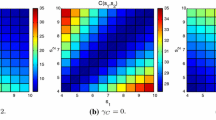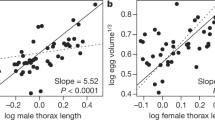Summary
Sex allocation theory is developed for hermaphrodites having frequent copulations and long-term sperm storage. Provided the sperm displacement mechanisms are similar to those known in insects, the ESS allocation to sperm versus eggs satisfies a rather simple rule. There are no data to test this rule, as yet.
Similar content being viewed by others
References
Baur, B. (1994) Multiple paternity and individual variation in sperm precedence in the simultaneously hermaphroditic land snailArianta arbustorum.Behav. Ecol. Sociobiol. 35, 413–421.
Brunet, J. (1992) Sex allocation in hermaphroditic plants.Trends Ecol. Evol. 7 79–84.
Charlesworth, D. and Charlesworth, B. (1987) The effect of investment in attractive structures on allocation to male and female functions in plants.Evolution 41 948–68.
Charlesworth, D. and Morgan, M. (1991) Allocation of resources to sex functions in flowering plants.Phil. Trans. R. Soc. B. 332 91–102.
Charnov, E. L. (1979a) Simultaneous hermaphroditism and sexual selection.Proc. Natl Acad. Sci. USA 76 2480–4.
Charnov, E. L. (1979b) Natural selection and sex change in Pandalid shrimp: test of a life history theory.Am. Nat. 113 715–34.
Charnov, E. L. (1982)The Theory of Sex Allocation. Princeton University Press, Princeton, NJ.
Charnov, E. L. (1993)Life History Invariants. Oxford University Press, Oxford.
Charnov, E. L. and Bull, J. J. (1977) When is sex environmentally determined?Nature 266 828–30.
Charnov, E. L. and Bull, J. J. (1989) Non-Fisherian sex ratios with sex change and environmental sex determination.Nature 338 148–50.
Charnov, E. L. and Downhower, J. F. (1995) A trade-off-invariant life-history rule for optimal offspring size.Nature 376 418–19.
Charnov, E. L., Maynard Smith, J. and Bull, J. J. (1976) Why be an hermaphrodite?Nature 263 125–6.
Charnov, E. L., Gotshall, D. and Robinson, J. (1978) Sex ratio: adaptive response to population fluctuation in Pandalid shrimp.Science 200 204–6.
Charnov, E. L., Los-Denhartogh, R. L., Jones, W. T. and Vanden Assem, J. (1981) Sex ratio evolution in a variable environment.Nature 289 27–33.
Fischer, E. A. (1980). The relationship between mating system and simultaneous hermaphroditism in the coral reef fishHypoplectrus nigricans (Serranidae).Anim. Behav. 28 620–33.
Fischer, E. A. (1981) Sexual allocation in a simultaneously hermaphroditic coral reef fish.Am. Nat. 117 64–82.
Fischer, E. A. (1984) Local mate competition and sex allocation in simultaneous hermaphrodites.Am. Nat. 121 590–6.
Fischer, E. A. and Petersen, C. W. (1987) The evolution of sexual patterns in the seabasses.Bioscience 37 482–9.
Fisher, R. A. (1958)The Genetical Theory of Natural Selection. Dover, New York.
Ghiselin, M. T. (1969) The evolution of hermaphroditism among animals.Q. Rev. Biol. 44 189–208.
Godfray, H. C. J. (1994)Parasitoids. Princeton University Press, Princeton, NJ.
Hamilton, W. D. (1967) Extraordinary sex ratios.Science 156 477–88.
Leonard, J. L. (1990) The hermaphrodite's dilemma.J. Theor. Biol. 147 361–72.
Leonard, J. L. (1991) Sexual conflict and the mating systems of simultaneously hermaphroditic gastropods.Am. Malacol. Bull. 9 45–58.
Leonard, J. L. (1992) The ‘love-dart’ in Helicid snails: a gift of calcium or a firm commitment?J. Theor. Biol. 159 513–21.
Leonard, J. L. (1993) Sexual conflict in simultaneous hermaphrodites: evidence from serranid fishes.Environ. Biol. Fish. 36 135–48.
Leonard, J. L. and Lukowiak, K. (1991) Sex and the simultaneous hermaphrodite: testing models of male—female conflict in a sea slug.Anim. Behav. 41 255–66.
Morris, W. F., Mangel, M. and Adler, F. R. (1995) Mechanisms of pollen deposition by insect pollinators.Evol. Ecol. 9 304–17.
Parker, G. A. (1970) Sperm competition and its evolutionary consequences in the insects.Biol. Rev. 45 528–68.
Parker, G. A. and Simmons, L. W. (1991) A model of constant random sperm displacement during mating: evidence fromScatophaga.Proc. R. Soc. B 246 107–15.
Parker, G. A. and Simmons, L. W. (1994) Evolution of phenotypic optima and copula duration in dungflies.Nature 370 53–6.
Parker, G. A., Simmons, L. W. and Kirk, H. (1990) Analyzing sperm competition data: simple models for predicting mechanisms.Behav. Ecol. Sociobiol. 27 55–65.
Petersen, C. W. (1987) Reproductive behaviour and gender allocation inSerranus fasciatus, a hermaphroditic reef fish.Anim. Behav. 35 1601–14.
Petersen, C. W. (1990a) The relationships among population density, individual size, mating tactics, and reproductive success in a hermaphroditic fish,Serranus fasciatus.Behaviour 113 57–80.
Petersen, C. W. (1990b) Sex allocation in simultaneous hermaphrodites: testing local mate competition theory. InSex Allocation and Sex Change: Experiments and Models (M. Mangel, ed.), pp. 183–205. The American Mathematical Society, Providence, RI.
Raimondi, P. T. and Martin, J. E. (1991) Evidence that mating group size affects allocation of reproductive resources in a simultaneous hermaphrodite.Am. Nat. 138 1206–17.
Sella, G. (1988) Reciprocation, reproductive success and safeguards against cheating in a hermaphroditic polychaete wormOphryotrocha diadema, Akesson 1976.Biol. Bull. 175, 212–17.
Sella, G. (1990) Sex allocation in the simultaneous hermaphorditic polychaete wormOphryotrocha diadema.Ecology 71, 27–32.
Sella, G. (1991) Evolution of biparental care in the hermaphroditic polychaete wormOphryotrocha diadema.Evolution 45, 63–8.
Trivers, R. L. and Hare, H. (1976) Haplodiploidy and the evolution of social insects.Science 191 249–63.
Warner, R. R. (1988) Sex change in fishes: hypotheses, evidence and objections.Environ. Biol. Fish. 22 81–90.
Werren, J. H. (1987) Labile sex ratios in wasps and bees.Bioscience 37 498–506.
Wrensch, D. L. and Ebbert, M. (eds) (1993)Evolution and Diversity of Sex Ratio in Insects and Mites. Chapman & Hall, London.
Author information
Authors and Affiliations
Rights and permissions
About this article
Cite this article
Charnov, E.L. Sperm competition and sex allocation in simultaneous hermaphrodites. Evol Ecol 10, 457–462 (1996). https://doi.org/10.1007/BF01237878
Issue Date:
DOI: https://doi.org/10.1007/BF01237878




